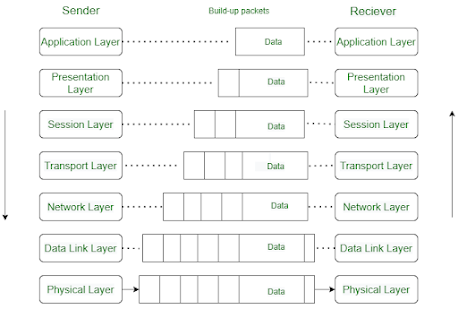OSI LAYER MODEL SENDER (STUDENT)
Data SENT through all the 7 layers from application layer to
physical layer.
Application layer is where human-computer interaction happen, where all the applications can access the network service. In doing so, this layer is responsible for providing services to the user. Back on the project scenario, the data from student’s computer or any device (sender side) travels to reach the Online Learning System server in Cobham College IT Centre. Through the use of network applications like web browsers, it provides a data transmission and reception application layer protocol. Example of protocols in this layer are :-
In this case, the student’s use Hypertext Transfer Protocol (HTTP). This protocol generate data that must be transferred via the network (search engine). For instance, https://www.online-learning-system-cobham-college.com.my. Thus, the data format will be specified by the application layer, and the data will be transmitted to the presentation layer which is layer 6.
In this presentation layer, the data from the application layer is retrieved and processed here so that it may be transmitted across the network in the required format. Another process that will happen in this layer is :-
This layer is in charge of handling packet delivery
from the sender to the receiver. The network layer will decide the IP address
and split the transport layer segment into packets. The data link layer will
receive the packets after that.
At the sender side (student) , the data link layer receives packets from the Network layer and divides them into small frames, then, sends each frame bit-by-bit to the physical layer.
7. PHYSICAL LAYER
The physical layer will get the data from the upper layer which is data link layer and convert it into bitstreams (0's and 1's) and send it through a physical channel. In this scenario the physical channel used are wireless and wired media.
OSI LAYER MODEL RECEIVER (SERVER - IT CENTER)
Data RECEIVED through all the 7 layers from physical layer
to application layer.
1. PHYSICAL LAYER
Data is received through physical channel from server at the IT center to the student. In this physical
layer, it will convert the bitstreams into frames to be passed to the data-link
layer (layer 2)
2. DATA LINK LAYER
The data link layer receives the information in the form of packets from the physical layer, The frames will be converted back into packets and transferred to the network layer.
3. NETWORK LAYER
The packet will be returned from the data link layer
to the transport layer during this section. The data link layer packet will be
converted back into segments and sent to the transport layer. Once the IP
address has been confirmed, the transport layer will be reached.
4.TRANSPORT LAYER
Transport Layer transmits the data it has received to the appropriate application by reading the port number from its header. The segmented data are additionally sequenced and reassembled. Then, data will be transferred to session layer.
The functions of the transport layer are as follows :
- Segmentation and Reassembly : The communication is split into smaller components and received from the (session) layer by this layer. Each segments that is created has a heading that goes with it. The message is put back together by the transport layer at the final station.
- Service Point Addressing : The transport layer header contains a form of address known as a service point address or port address in order to send the message to the appropriate process. The transport layer ensures that the message is delivered to the appropriate process by supplying this address.
The services provided by the transport layer :
a) Connection-Oriented Service :
– Connection Establishment
– Data Transfer
– Termination / disconnection
After a packet or set of packets is received in this sort of communication, the receiving device sends an acknowledgement to the source. This form of transmission is trustworthy and safe.
b) Connectionless Service : It consists of Data Transfer and is a one-phase operation. The receiver in this transmission style does not confirm receipt of a packet. This method enables considerably quicker device connectivity. Connection-oriented service is more reliable than connectionless Service.
5.SESSION LAYER
The interaction between communication systems is maintained, established, and synchronised by the session layer. Determines which communication stream the data belongs to using the session information. Once a decision has been made, the data will be transmitted to Layer 6 or the Presentation Layer.
6. PRESENTATION LAYER
At the presentation layer (receiver) side which is the Online Learning System server in the Cobham College IT Centre, it receives data from the session layer and performs the data translation, decryption, and decompression.
Unlike data encryption, data decryption reverses the encryption process, restoring the communication to its original state.
7. APPLICATION LAYER
THE COMMUNICATION PROCESS IN THE OSI MODEL:


.png)








Comments
Post a Comment